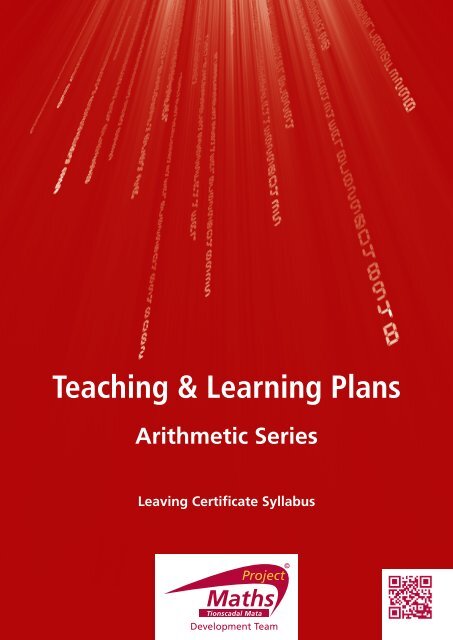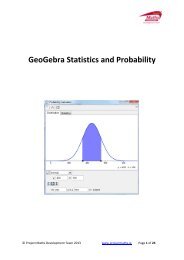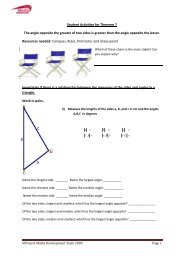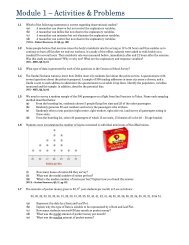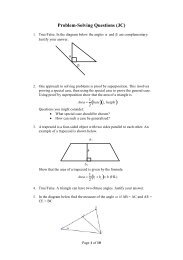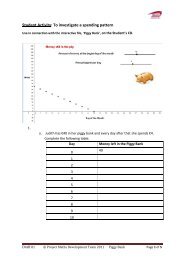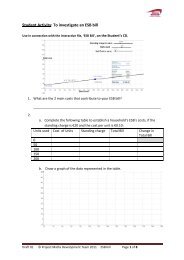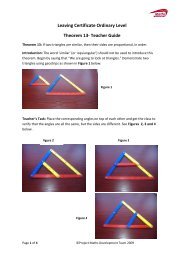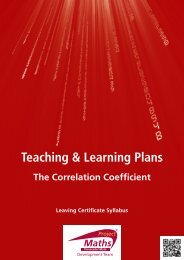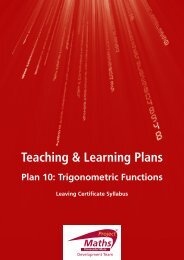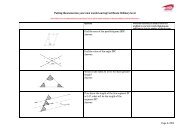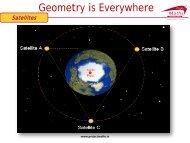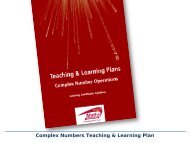Teaching & Learning Plans - Project Maths
Teaching & Learning Plans - Project Maths
Teaching & Learning Plans - Project Maths
Create successful ePaper yourself
Turn your PDF publications into a flip-book with our unique Google optimized e-Paper software.
<strong>Teaching</strong> & <strong>Learning</strong> <strong>Plans</strong><br />
Arithmetic Series<br />
Leaving Certificate Syllabus
The <strong>Teaching</strong> & <strong>Learning</strong> <strong>Plans</strong><br />
are structured as follows:<br />
Aims outline what the lesson, or series of lessons, hopes to achieve.<br />
Prior Knowledge points to relevant knowledge students may already have and also<br />
to knowledge which may be necessary in order to support them in accessing this new<br />
topic.<br />
<strong>Learning</strong> Outcomes outline what a student will be able to do, know and understand<br />
having completed the topic.<br />
Relationship to Syllabus refers to the relevant section of either the Junior and/or<br />
Leaving Certificate Syllabus.<br />
Resources Required lists the resources which will be needed in the teaching and<br />
learning of a particular topic.<br />
Introducing the topic (in some plans only) outlines an approach to introducing the<br />
topic.<br />
Lesson Interaction is set out under four sub-headings:<br />
i. Student <strong>Learning</strong> Tasks – Teacher Input: This section focuses on possible lines<br />
of inquiry and gives details of the key student tasks and teacher questions which<br />
move the lesson forward.<br />
ii.<br />
Student Activities – Possible Responses: Gives details of possible student<br />
reactions and responses and possible misconceptions students may have.<br />
iii. Teacher’s Support and Actions: Gives details of teacher actions designed to<br />
support and scaffold student learning.<br />
iv.<br />
Assessing the <strong>Learning</strong>: Suggests questions a teacher might ask to evaluate<br />
whether the goals/learning outcomes are being/have been achieved. This<br />
evaluation will inform and direct the teaching and learning activities of the next<br />
class(es).<br />
Student Activities linked to the lesson(s) are provided at the end of each plan.
<strong>Teaching</strong> & <strong>Learning</strong> Plan:<br />
Leaving Certificate Syllabus<br />
Aims<br />
• To understand the concept of arithmetic series<br />
• To use and manipulate the appropriate formulas<br />
• To apply the knowledge of arithmetic series in a variety of contexts<br />
• To deal with combinations of arithmetic sequences and series and<br />
distinguish between them<br />
Prior Knowledge<br />
Students have prior knowledge of:<br />
• the concept of Patterns<br />
• basic number systems<br />
• sequences<br />
• basic graphs in the co-ordinate plane<br />
• simultaneous equations with 2 unknowns<br />
• T n<br />
as the n th term of a sequence.<br />
<strong>Learning</strong> Outcomes<br />
As a result of studying this topic, students will be able to:<br />
• recognise arithmetic series in a variety of contexts<br />
• recognise series that are not arithmetic<br />
• apply their knowledge of arithmetic series in a variety of contexts<br />
• apply the relevant formulas in both theoretical and practical situations<br />
• given information about a sequence or series, students should be able to<br />
derive the first term (a), the common difference (d) ,the nth term (T n<br />
) and<br />
the sum of the first n terms (S n<br />
).<br />
© <strong>Project</strong> <strong>Maths</strong> Development Team 2011 www.projectmaths.ie 1
<strong>Teaching</strong> & <strong>Learning</strong> Plan: Arithmetic Series<br />
Catering for Learner Diversity<br />
In class, the needs of all students, whatever their level of ability are equally important. In<br />
daily classroom teaching, teachers can cater for different abilities by providing students<br />
with different activities and assignments graded according to levels of difficulty so<br />
that students can work on exercises that match their progress in learning. Less able<br />
students, may engage with the activities in a relatively straightforward way while the<br />
more able students should engage in more open-ended and challenging activities. In this<br />
<strong>Teaching</strong> and <strong>Learning</strong> Plan, for example, teachers can provide students with different<br />
applications of arithmetic series and with appropriate amounts and styles of support.<br />
In interacting with the whole class, teachers can make adjustments to suit the needs<br />
of students. For example, derive the formula for an arithmetic series in order to<br />
gain a greater understanding of the topic.<br />
Apart from whole-class teaching, teachers can utilise pair and group work to encourage<br />
peer interaction and to facilitate discussion. The use of different grouping arrangements<br />
in these lessons should help ensure that the needs of all students are met and that<br />
students are encouraged to verbalise their mathematics openly and to share their<br />
learning.<br />
Relationship to Leaving Certificate Syllabus<br />
Students<br />
learn about<br />
3.1 Number<br />
systems<br />
Students<br />
working at FL<br />
should be able<br />
to<br />
In addition,<br />
students working<br />
at OL should be<br />
able to<br />
––<br />
find the sum to<br />
n terms of an<br />
arithmetic series<br />
In addition,<br />
students working<br />
at HL should be<br />
able to<br />
© <strong>Project</strong> <strong>Maths</strong> Development Team 2011 www.projectmaths.ie 2
Student <strong>Learning</strong> Tasks: Teacher<br />
Input<br />
<strong>Teaching</strong> & <strong>Learning</strong> Plan: Arithmetic Series<br />
Student Activities: Possible<br />
Responses<br />
Lesson Interaction<br />
Teacher’s Support and Actions<br />
Assessing the <strong>Learning</strong><br />
Section A: To find the sum of first n terms of an arithmetic series<br />
»»<br />
Try this question with or<br />
without your calculator. “If Seán<br />
saves €40 for the first week and<br />
increases this amount by €5 per<br />
week each week thereafter»<br />
(i) how much will he save in<br />
the10 th week?<br />
(ii) how much in total will he<br />
have saved after the first 10<br />
weeks?»<br />
• €40, €45, €50, €55, €60,<br />
€65, €70, €75, €80, €85<br />
»<br />
»<br />
• Answer €85<br />
• €40 + €45 + €50 + €55 +<br />
€60 + €65 + €70 + €75 +<br />
€80 + €85 = €625<br />
Note: As the formula will not yet be<br />
introduced the emphasis at this stage is<br />
on getting the students to understand<br />
the difference in how much Seán will<br />
save on the 10 th week and how much in<br />
total will he have saved after the first 10<br />
weeks?<br />
»»<br />
Can students<br />
successfully complete<br />
the question?»<br />
»»<br />
Do the students<br />
understand the<br />
difference in<br />
phrasing of parts<br />
(i) and (ii) of the<br />
question?»<br />
Teacher Reflections<br />
»»<br />
Which answer is bigger and<br />
why?<br />
• The total for the 10 weeks is<br />
bigger because the savings<br />
for each week are added.<br />
»<br />
»<br />
»<br />
»<br />
»<br />
»<br />
»<br />
»»<br />
Can they relate this<br />
difference to the<br />
question posed?<br />
»»<br />
Do the students<br />
understand the<br />
relationship between<br />
the 10th term and<br />
the sum of the first<br />
10 terms?»<br />
»<br />
»»<br />
The amount Seán saved in the<br />
10 th week is known as the 10 th<br />
term of the series and the total<br />
amount he had saved in the first<br />
10 weeks is known as the sum of<br />
the first ten terms (or the partial<br />
sum) of the series.»<br />
»»<br />
Can anyone tell me if there is a<br />
relationship between arithmetic<br />
sequences and series and if so<br />
what is it?<br />
• There is a relationship. An<br />
arithmetic series is formed<br />
when the terms of an<br />
arithmetic sequence are<br />
added together.<br />
»»<br />
Write on the board the 10 th term of<br />
the series (€85) and the sum of the<br />
first ten terms of the series: €40 + €45<br />
+ €50 + €55 + €60 + €65 + €70 + €75 +<br />
€80 + €85 = €625.<br />
»»<br />
Explain that when the series is written<br />
in the form €40 + €45 + €50 + €55 +<br />
€60 + €65 + €70 + €75 + €80 + €85 is<br />
referred to as the unevaluated sum.»<br />
»»<br />
Explain that €40, €45, €50, €55, €60,<br />
€65, €70, €75, €80, €85 … constitutes<br />
a sequence whereas €40 + €45 + €50<br />
+ €55 + €60 + €65 + €70 + €75 + €80 +<br />
€85 is the corresponding series.<br />
» » Do the students<br />
understand that<br />
when the terms of a<br />
sequence are added<br />
together, a series is<br />
formed?<br />
© <strong>Project</strong> <strong>Maths</strong> Development Team 2011 www.projectmaths.ie KEY: » next step • student answer/response 3
<strong>Teaching</strong> & <strong>Learning</strong> Plan: Arithmetic Series<br />
Student <strong>Learning</strong> Tasks:<br />
Teacher Input<br />
»»<br />
Emily earned €20,000 in her<br />
first year of employment<br />
and got an annual increase<br />
of €4.000, thereafter.<br />
How much will she earn<br />
in the eigth year of her<br />
employment and how much<br />
will her total earnings be in<br />
the first eight years?»<br />
Student Activities: Possible<br />
Responses<br />
• €20,000 + €4,000 + €4,000 +<br />
€4,000 + €4,000 + €4,000 +<br />
€4,000 + €4,000 = €48,000<br />
Teacher’s Support and Actions<br />
Assessing the <strong>Learning</strong><br />
• Her total earnings will be<br />
€20,000 + €24,000 + €28,000<br />
+ €32,000 + €36,000 +<br />
€40,000 + €44,000 + €48,000<br />
= €272,000<br />
»»<br />
Delay telling students the<br />
algorithm. Allow students to<br />
explore this for themselves.»<br />
Note: for less able students,<br />
the teacher can select smaller<br />
numbers, but students will<br />
appreciate the difference more if<br />
working with larger figures.»<br />
»»<br />
Did students arrive at<br />
the correct answer for<br />
both questions? »<br />
»»<br />
Did any students have<br />
misconceptions?<br />
Teacher Reflections<br />
»»<br />
Does this seem like a<br />
reasonable answer? Explain.<br />
• Yes. Without any increase<br />
in salary Emily would earn<br />
€20,000 × 8 = €160,000.<br />
With the increase each year,<br />
the total should be greater<br />
than €160,000.<br />
»»<br />
Ask an individual student to<br />
write the solutions on the<br />
board and explain what they<br />
are doing in each step.<br />
»»<br />
If we need to calculate<br />
Emily’s earnings over thirty<br />
years we will need a less time<br />
consuming and more robust<br />
technique. »<br />
»»<br />
The formula for the sum<br />
of the first n terms of an<br />
arithmetic series is »<br />
»<br />
(See Tables and Formulae<br />
booklet).»<br />
a = First term<br />
n= Number of terms<br />
d= Common difference<br />
S n = Sum of the first n terms<br />
»»<br />
Write the formula »<br />
»<br />
and the meaning of the terms<br />
on the board.»<br />
»»<br />
The proof of this formula can<br />
be seen in Appendix A and it<br />
is recommended that where<br />
appropriate a class should be<br />
shown how it is derived.»<br />
»»<br />
Write down the formula<br />
for T n as well and use the<br />
opportunity provided by the<br />
problems on series to revise<br />
the use of the formula.<br />
»»<br />
Do the students<br />
understand that a, d<br />
and n have the same<br />
meaning as they had<br />
for an arithmetic<br />
sequence?»<br />
»»<br />
Can students explain<br />
what each of the<br />
terms mean?»<br />
» » Do all students<br />
understand the<br />
differences between<br />
arithmetic sequences<br />
and series?<br />
© <strong>Project</strong> <strong>Maths</strong> Development Team 2011 www.projectmaths.ie KEY: » next step • student answer/response 4
Student <strong>Learning</strong> Tasks: Teacher Input Student Activities:<br />
Possible Responses<br />
»»<br />
Now I want you to work in pairs.<br />
One student is to be called student A<br />
and the other student in the group<br />
student B.»<br />
»»<br />
Student A, write down an arithmetic<br />
series containing at least ten terms<br />
and inform student B of the first<br />
number, the common difference and<br />
the number of terms in the series.»<br />
»»<br />
Student B must now find the partial<br />
sum (the sum to n terms) of the<br />
chosen series using the formula.<br />
Student A must find the sum using<br />
their calculator. Then compare your<br />
answers.<br />
»»<br />
Look at Section A: Student Activity<br />
1 and commence problems 1, 2, 3, 6<br />
and 7.<br />
<strong>Teaching</strong> & <strong>Learning</strong> Plan: Arithmetic Series<br />
Teacher’s Support and<br />
Actions<br />
»»<br />
On the board, write the<br />
formula and what each<br />
letter represents:»<br />
a = First term<br />
n= Number of terms<br />
d= Common difference<br />
S n = Sum of the first n terms<br />
»»<br />
Walk around the room and<br />
check that all students are<br />
engaged in creating their<br />
own problem.»<br />
»»<br />
When some groups have<br />
completed the exercise they<br />
can be asked to reverse the<br />
roles.<br />
»»<br />
As students progress<br />
through this activity sheet<br />
the lesson can be stopped<br />
from time to time and<br />
discussions developed in<br />
relation to the questions.<br />
The content of this<br />
discussion will depend on<br />
what the teacher has seen<br />
in the students’ answers.»<br />
»»<br />
Further questions from<br />
the Section A: Student<br />
Activity 1 can be given for<br />
homework.<br />
Assessing the <strong>Learning</strong><br />
»»<br />
Can students verbally express<br />
their own everyday examples of<br />
arithmetic sequence and series?»<br />
»»<br />
Did all students devise their<br />
own problem?»<br />
»»<br />
Were all students able to apply<br />
the formula correctly to the<br />
problem?»<br />
»»<br />
Were the students’<br />
misconceptions addressed as a<br />
result of doing the problems?<br />
»»<br />
Are students developing the<br />
formula for S n ?<br />
»»<br />
Are the students clear that<br />
(i) a 1 , a 2 , a 3 ... constitutes a<br />
sequence and that a 1 + a 2 + a 3<br />
+ ... is the corresponding series?<br />
»»<br />
(ii)<br />
is the general term of an<br />
arithmetic sequence and that»<br />
»<br />
gives the partial sum (the sum<br />
to n terms) of an arithmetic<br />
series?<br />
Teacher Reflections<br />
© <strong>Project</strong> <strong>Maths</strong> Development Team 2011 www.projectmaths.ie KEY: » next step • student answer/response 5
Student <strong>Learning</strong> Tasks:<br />
Teacher Input<br />
<strong>Teaching</strong> & <strong>Learning</strong> Plan: Arithmetic Series<br />
Student Activities: Possible<br />
Responses<br />
Teacher’s Support and<br />
Actions<br />
Assessing the<br />
<strong>Learning</strong><br />
Section B: To further develop the concept of S n of an arithmetic series<br />
»»<br />
Now, I want you all to try<br />
the interactive quiz called<br />
“Arithmetic Series” on the<br />
Students' CD.<br />
»»<br />
We know that the sum<br />
of the first eight terms of<br />
an arithmetic series is 80<br />
and that the sum of the<br />
first sixteen terms is 288.<br />
How can we represent this<br />
information using algebra?»<br />
»»<br />
Now, what types of<br />
equations do we have<br />
and what can we do with<br />
them?»<br />
»<br />
»<br />
»»<br />
If computers are not<br />
available, hard copies of the<br />
quiz can be printed for the<br />
students.<br />
»»<br />
Write the question and<br />
the students’ responses on<br />
the board and discuss each<br />
stage as it progresses.»<br />
Note: Delay giving the<br />
procedure.<br />
»»<br />
Are students<br />
getting the<br />
majority of<br />
answers correct?<br />
»»<br />
Can students<br />
develop the<br />
equations?»<br />
»»<br />
Can students solve<br />
the equations?»<br />
»»<br />
Do students<br />
understand the<br />
meaning of the<br />
solution of these<br />
equations?»<br />
Teacher Reflections<br />
»»<br />
What information does<br />
this give us?<br />
• We have Simultaneous Equations<br />
and we can solve them.<br />
2a + 15d = 36<br />
2a + 7d = 20<br />
8d = 16<br />
d = 2<br />
2a+15(2) = 36<br />
2a = 6<br />
a = 3<br />
»»<br />
Are the students<br />
certain that the 8 th<br />
term is given by »<br />
»<br />
and that the sum<br />
to eight terms is<br />
given by »<br />
»<br />
• The first term is 3 and the common<br />
difference is 2.<br />
© <strong>Project</strong> <strong>Maths</strong> Development Team 2011 www.projectmaths.ie KEY: » next step • student answer/response 6
<strong>Teaching</strong> & <strong>Learning</strong> Plan: Arithmetic Series<br />
Student <strong>Learning</strong> Tasks: Teacher Input<br />
Student Activities: Possible<br />
Responses<br />
Teacher’s Support and<br />
Actions<br />
Assessing the<br />
<strong>Learning</strong><br />
»»<br />
Do questions 1-9 in Section B: Student<br />
Activity 2.<br />
»»<br />
Compare your answers around the class<br />
and have a discussion if the answers do<br />
not all agree.<br />
»»<br />
Teacher distributes<br />
Section B: Student<br />
Activity 2.<br />
Note: Select questions<br />
depending on the<br />
ability and progress of<br />
the students.»<br />
»»<br />
Are students able to<br />
complete the given<br />
question?»<br />
» » Are any<br />
misconceptions<br />
realised and<br />
rectified?<br />
Teacher Reflections<br />
»»<br />
Encourage students<br />
to explain their<br />
reasoning.»<br />
»»<br />
Allocate the more<br />
difficult questions<br />
to the students who<br />
have made most<br />
progress to date.<br />
© <strong>Project</strong> <strong>Maths</strong> Development Team 2011 www.projectmaths.ie KEY: » next step • student answer/response 7
<strong>Teaching</strong> & <strong>Learning</strong> Plan: Arithmetic Series<br />
Student <strong>Learning</strong> Tasks:<br />
Teacher Input<br />
»»<br />
A runner is already running<br />
1km per day and decides<br />
to increase this amount by<br />
0.1km per day starting on<br />
the 1 st August.<br />
How far does he run on the<br />
10 th August?<br />
»<br />
Student Activities: Possible<br />
Responses<br />
»»<br />
»<br />
»<br />
»<br />
»<br />
»<br />
»<br />
Teacher’s Support and<br />
Actions<br />
»»<br />
Write the problem on the<br />
board.»<br />
Assessing the <strong>Learning</strong><br />
»»<br />
Why is a equal to 1.1?<br />
»<br />
»<br />
»<br />
»»<br />
If you used the formula»<br />
»<br />
to calculate this, what value<br />
was a (the first term)?<br />
»<br />
• Because the 1km was the<br />
distance he was running before<br />
the 1 st August and was not the<br />
first term. 1.1 was the first term. »<br />
• 1.1<br />
»<br />
»<br />
»<br />
»<br />
»»<br />
Give students time to<br />
explore possibilities<br />
and to discuss what is<br />
happening.»<br />
»»<br />
Encourage students to<br />
explain their reasoning.»<br />
»»<br />
Walk around the room<br />
and check the students’<br />
responses to the<br />
questions on the activity<br />
sheet.<br />
»»<br />
Do the students<br />
recognise that 1.1 is the<br />
first term?»<br />
» » Do students recognise<br />
the need to read all<br />
questions carefully?<br />
Teacher Reflections<br />
»»<br />
Find the total distance he<br />
ran up to and including 10 th<br />
August.<br />
• »<br />
»<br />
»»<br />
As in earlier examples you<br />
need to read the question<br />
carefully to establish, the<br />
value of the first term.»<br />
»»<br />
Now do questions 10 and<br />
11 in Section B: Student<br />
Activity 2.<br />
© <strong>Project</strong> <strong>Maths</strong> Development Team 2011 www.projectmaths.ie KEY: » next step • student answer/response 8
<strong>Teaching</strong> & <strong>Learning</strong> Plan: Arithmetic Series<br />
Student <strong>Learning</strong> Tasks: Teacher<br />
Input<br />
Reflection<br />
»»<br />
Now to recap, what do you<br />
understand by the word<br />
‘arithmetic’ sequence?»<br />
»<br />
»»<br />
Can you tell me anything you<br />
know about a sequence?»<br />
»<br />
»<br />
»<br />
»<br />
»<br />
»<br />
»<br />
»»<br />
What can you tell be about a<br />
series?»<br />
»<br />
»<br />
»<br />
Student Activities:<br />
Possible Responses<br />
• Arithmetic means<br />
that any term can be<br />
obtained by adding a<br />
fixed number to the<br />
preceding term.»<br />
• A sequence is a group/<br />
array of numbers that<br />
are in some form of<br />
pattern.»<br />
Arithmetic sequences<br />
have a common<br />
difference i.e. »<br />
»<br />
• If the sequence is for<br />
example 1, 3, 5, 9,…»<br />
»<br />
then the series is»<br />
1 + 3 + 5 + 7 + 9 + …»<br />
Teacher’s Support and Actions<br />
»»<br />
It is important that this section<br />
is concluded on a positive note<br />
and that students can see that<br />
arithmetic sequences and series<br />
are relevant and are encountered<br />
in everyday life.»<br />
»»<br />
Write a number of sequences on<br />
the board so that student are clear<br />
that sequences take the form a 1 ,<br />
a 2 , a 3 ...<br />
»»<br />
Write a number of series on<br />
the board so that the students<br />
are clear that a series is the<br />
unevaluated sum a 1 + a 2 + a 3 + ...<br />
»»<br />
Make sure that the students<br />
recognise that the general term of<br />
an arithmetic sequence is also the<br />
general term of the series.<br />
Assessing the<br />
<strong>Learning</strong><br />
»»<br />
Are the students<br />
confident in their<br />
knowledge of this<br />
topic?»<br />
»»<br />
Can students<br />
effectively articulate<br />
the concept?»<br />
» » Can students explain<br />
the properties<br />
of arithmetic<br />
sequences and<br />
series?<br />
Teacher Reflections<br />
»»<br />
How is an arithmetic series<br />
formed?<br />
• It is formed when the<br />
terms of the arithmetic<br />
sequence are added<br />
together.<br />
© <strong>Project</strong> <strong>Maths</strong> Development Team 2011 www.projectmaths.ie KEY: » next step • student answer/response 9
<strong>Teaching</strong> & <strong>Learning</strong> Plan: Arithmetic Series<br />
Appendix A<br />
Proof of Formula for arithmetic series<br />
(Students will not be required to prove this formula.)<br />
S n = T 1 + T 2 + T 3 + T 4 + ............................................... T n-1 + T n<br />
S n = a + a + d + a + 2d + a + 3d +..........a + (n-2)d + a + (n-1)d (1)<br />
Note S n can also be written as T n + T n-1 ...............+T 4 + T 3 + T 2 + T 1<br />
Writing S n in reverse:<br />
S n = a + (n-1)d + a + (n-2)d ..................... a + 3d + a + 2d + a + d +a (2)<br />
Adding (1) and (2)<br />
S n = a + a + d + a + 2d + a + 3d +..........a + (n-2)d + a + (n-1)d (1)<br />
S n = a + (n-1)d + a + (n-2)d ..................... a + 3d + a + 2d + a + d +a (2)<br />
2 S n = {2a + (n-1)d} + {2a + (n-1)d} + {2a + (n-1)d}.....+{2a + (n-1)d} + {2a + (n-1)d}<br />
2 S n = n{2a + (n-1)d}<br />
S n =<br />
{2a + (n-1)d} Formula as per tables but note<br />
S n = {a + a + (n-1)d} = {first term + n th term}<br />
© <strong>Project</strong> <strong>Maths</strong> Development Team 2011 www.projectmaths.ie 10
<strong>Teaching</strong> & <strong>Learning</strong> Plan: Arithmetic Series<br />
Section A: Student Activity 1<br />
(Calculations must be shown in all cases.)<br />
1. A craftsman uses 100 beads on the first day of the month and this<br />
amount increases by 15 beads each day thereafter. If he works 24 days<br />
in the month, how many beads will he need to order in advance to<br />
have a month’s supply?<br />
6<br />
2<br />
2. Find the total amount of metal required to continue<br />
this shape with 20 sides. The lengths of the sides are in<br />
metres.<br />
5<br />
A<br />
4<br />
1<br />
3<br />
7<br />
G<br />
3. A factory produced 10, 13, 16 and 19 items per week in the first four<br />
weeks of the year. If this pattern continues how many items will this<br />
factory produce in the last week of the year and how many items will<br />
the factory produce in total in a complete year of business (52 weeks in<br />
the year)?<br />
4. If James saves €40 during the first week of January and increases this<br />
amount by €5 per week every week for the following ten weeks, how<br />
much will he save in total?<br />
5. A woman has a starting salary of €20,000 and gets an annual increase<br />
of €2,000 per year thereafter. How much will she earn in total during<br />
her working life, if she retires after working for 40 years?<br />
6. Your new employer offers you a choice of 2 salary packages. Package<br />
A has a starting salary of €12,000 per year with an annual increase<br />
of €2,000. Package B has a starting salary of €20,000 and an annual<br />
increase of €1,500. Assuming you plan to remain in the firm for ten<br />
years which is the best package and by how much? Illustrate your<br />
reasoning with the help of calculations.<br />
7. In a cinema, there are 140 seats in the front row, 135 in the second and<br />
130 in the third row. This pattern continues until the last row. If the last<br />
row has 45 seats, how many rows are there in the cinema? Calculate<br />
the total number of seats in the cinema.<br />
© <strong>Project</strong> <strong>Maths</strong> Development Team 2011 www.projectmaths.ie 11
<strong>Teaching</strong> & <strong>Learning</strong> Plan: Arithmetic Series<br />
Section A: Student Activity 1 (continued)<br />
8. Find an expression for S n for the arithmetic Series 2+4+6+8+….<br />
9. How many terms of the arithmetic series 1 + 3 + 5 +.... are required to<br />
give a sum in excess of 600?<br />
10. Kayla got her new mobile phone on the first of April. She sent 1 text<br />
that day, 3 texts the next day and 5 texts the next day. If this pattern<br />
continues how many texts will she send on 30 th April and how many<br />
texts in total will she send in the month of April that year? (April has<br />
30 days.) If each text message costs 13 cent how much will she spend<br />
sending texts in April?<br />
11. Is it possible for an arithmetic series to have a first term and a common<br />
difference that are both non-zero and have a partial sum of zero? If so,<br />
give an example and explain the circumstance that causes this to happen.<br />
12. A water tank containing 377 litres of water develops a leak. On the first<br />
day the tank leaks 5 litres of water and this increases by 4 litres each day<br />
thereafter. Show that the amount of water that leaks each day follows<br />
an arithmetic progression and apply the S n formula to determine how<br />
long it takes for the tank to empty. Show your calculations.<br />
13. A bricklayer has 400 bricks and wants to build a wall following the<br />
pattern below. How many layers high will the wall be if he plans to use<br />
all his bricks?<br />
© <strong>Project</strong> <strong>Maths</strong> Development Team 2011 www.projectmaths.ie 12
<strong>Teaching</strong> & <strong>Learning</strong> Plan: Arithmetic Series<br />
Section B: Student Activity 2<br />
(Calculations must be shown in all cases.)<br />
1. For a given arithmetic series, S 4 = 26 and S 6 = 57, find T n .<br />
2. The terms of an arithmetic sequence are given by the formula T n = 25−4n.<br />
a. Find the first three terms of the sequence. What is the value of d, the<br />
common difference?<br />
b. Find the first negative term of the sequence.<br />
c. For what value of n is the sum of the first n terms of the series equal<br />
to 30?<br />
3. Given that S 1 of an arithmetic series is -3 and S 2 of the same series is 3.<br />
a. Find the common difference.<br />
b. Find the 20 th term of the equivalent sequence.<br />
c. When S n of this series is equal to 75, what value has n?<br />
4. Jonathan saved a certain amount for one year and increased this amount<br />
by a regular amount each year thereafter. If the total amount he saved in<br />
the first 8 years of this savings plan is €1,690 and he saved €220 in the 5 th<br />
year. Find how much he saved in the first year and by how much did he<br />
increase his savings each year.<br />
5. The sum of the first n terms of an arithmetic series is given by<br />
S n = n 2 − 15n.<br />
a. Find the first term and the common difference.<br />
b. Find T n the n th term of the equivalent sequence.<br />
c. When is the series equal to -50?<br />
6. The first 4 terms of arithmetic series is -3 + 4 + 11 + 18 +...<br />
a. Find d, the common difference.<br />
b. Find T 20 , the 20 th term of the equivalent sequence.<br />
c. Find S 20 , the sum of the first twenty terms of the series.<br />
© <strong>Project</strong> <strong>Maths</strong> Development Team 2011 www.projectmaths.ie 13
<strong>Teaching</strong> & <strong>Learning</strong> Plan: Arithmetic Series<br />
Section B: Student Activity 2 (continued)<br />
7. Three consecutive terms of an arithmetic sequence are x + 3, 4x + 1 and<br />
6x + 1. Find the value of x. Find an expression for S n the equivalent<br />
series.<br />
8. If a household uses 1kg of sugar each week and decideds to reduce<br />
this amount by 10g per week. How much sugar per week would the<br />
household be using at the end of the year (52 weeks in the year)? What<br />
is the total amount of sugar this household would use that year?<br />
9. Prove that the formula for the sum of the first n Natural Numbers (N) is<br />
N = {1, 2, 3, 4, ...}<br />
10. Emer purchases a new car every year on 1 st January. She purchased her<br />
first car in 2001 and it cost €20,000. Each year after that the cost of her<br />
new car increases by €3,000.<br />
a. How much did she spend on her 10 th car?<br />
b. How much did she spend on the car she purchased in 2011?<br />
c. Why were the previous two answers not the same?<br />
d. How much did she spend, in total, on her first ten cars?<br />
e. By 1 st February 2011, how much would she have spent on cars,<br />
assuming that she bought no cars other than those in the pattern<br />
mentioned in this question?<br />
11. Emer purchases a new car every second year on 1 st January. If the first<br />
car she purchases costs €20,000 and each time she changes the cost<br />
increasses by €6,000<br />
a. how much will she have spent in total in buying the cars on<br />
1 st February, ten years after she bought the first car?<br />
b. how much will she spend in total on her first ten cars?<br />
© <strong>Project</strong> <strong>Maths</strong> Development Team 2011 www.projectmaths.ie 14


